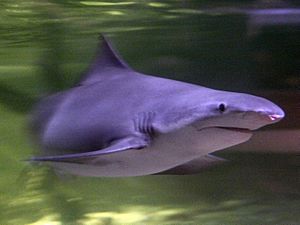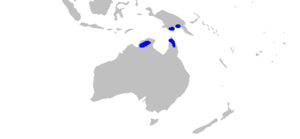Speartooth shark facts for kids
Quick facts for kids Sabor tooth shark |
|
|---|---|
 |
|
| Conservation status | |
| Scientific classification | |
| Genus: |
Glyphis
|
| Species: |
glyphis
|
 |
|
| Range of the speartooth shark | |
The speartooth shark (Glyphis glyphis) is a very rare type of river shark. It belongs to the requiem shark family. This shark lives in coastal ocean waters and the tidal parts of large tropical rivers. You can find it in northern Australia and New Guinea. Even though it's called a "river shark," it also lives near the shore in the ocean. It likes murky (cloudy) water with different salt levels.
This strong, gray shark has a short, wide snout and tiny eyes. It also has a fairly large second dorsal fin (the fin on its back). You can spot a black mark under each pectoral fin (the fins on its sides) near the tip. Its teeth are also special. The upper teeth are large, triangle-shaped, and have jagged edges. The lower teeth are narrow, like spears, with jagged edges only near their tips. Adult speartooth sharks can grow to about 2.6 m (8.5 ft) long.
Speartooth sharks hunt bony fish and crabs or prawns that live near the bottom. They are good at hunting in almost total darkness. These sharks are not as active as other requiem sharks. They move up and down rivers with the tidal currents to save energy. Female sharks give birth to live young, and the babies are connected to their mother by a placenta. However, we don't know many details about how they reproduce.
The speartooth shark is in danger because it often gets caught by accident in commercial and recreational fishing nets. Its home is also being damaged. Because there are so few of them, and they need very specific places to live, these sharks are very sensitive to these problems. The International Union for the Conservation of Nature has listed this species as endangered.
Contents
Discovering the Speartooth Shark
Two German scientists, Johannes Peter Müller and Friedrich Gustav Jakob Henle, first described the speartooth shark. They named it Carcharias (Prionodon) glyphis in their book published between 1839 and 1841. Their description was based on a stuffed young female shark, about 1 m (3.3 ft) long. No one knew exactly where this shark came from, but it might have been from the Indian Ocean or the South China Sea.
Later, in 1843, a Swiss-American zoologist named Louis Agassiz suggested a new group, or genus, called Glyphis for this shark. This name is now used for all river sharks. For a long time, the shark Müller and Henle described was the only known speartooth shark. Then, in 1982, other sharks were caught in Australia. These were called "Bizant river sharks." Scientists later confirmed that these were the same species as G. glyphis. So, in Australia, this shark is also known as the Bizant river shark or the Queensland river shark.
Where Speartooth Sharks Live
Young speartooth sharks live in a few large, mangrove-lined tropical rivers in northern Australia and New Guinea. They can be found from the river mouth (estuary) to hundreds of kilometers upstream. There is one possible record of this shark from the South China Sea.
In Queensland, Australia, you can find them in the Wenlock, Ducie, and Bizant Rivers. They might also live in the Normanby, Hey, and Embly Rivers. In the Northern Territory, they are known from the Adelaide River and the Alligator Rivers. The river sharks in the Ord River in Western Australia might also be this species. In New Guinea, this shark has been seen near Daru island, Port Romilly, and in the Fly River.
Habitat Details
Newborn and young speartooth sharks live only in areas with strong tidal currents and muddy river bottoms. The moving water makes the water very cloudy (turbid). So little sunlight gets through that you can't see more than 1 m (3.3 ft) deep. The saltiness of these waters can change a lot, from almost fresh (0.8 parts per thousand) to almost ocean water (28 parts per thousand). The water temperature ranges from 25 to 33 °C (77 to 91 °F).
Younger sharks usually live further upstream than older ones. A study in the Adelaide River tracked three sharks. It showed they moved upstream when the tide came in and downstream when the tide went out. They traveled about 10–12 km (6.2–7.5 mi) each way. One shark was found to swim at an average depth of 7.7 m (25 ft), which is in the middle of the water column. For a long time, adult speartooth sharks were a mystery. But in 2014, scientists found three adults (two males and one female) near Daru island in Papua New Guinea. All three were caught in the ocean waters off the island.
What Speartooth Sharks Look Like
For many years, scientists weren't sure how big this shark could get because they hadn't found any adults. But in 2014, the first adult sharks were found. We now know they can reach a length of about 2.6 m (8.5 ft).
The speartooth shark has a smooth, strong body with a short, wide head. Its snout is flat, and its large nostrils have flaps of skin that divide them. The eyes are small and have special protective eyelids called nictitating membranes. Its large, curved mouth has very short grooves at the corners. It has 26 to 29 rows of teeth in its upper jaw and 27 to 29 rows in its lower jaw. The teeth are tall and stand straight up. The upper teeth are wide and triangular with jagged edges. The lower teeth are narrow and spear-like, with jagged edges only near the tip. Very young sharks might have tiny bumps at the base of their lower teeth. They have five pairs of gill slits, and the first pair is longer than the others.
Fins and Color
The large pectoral fins have curved front edges and inward-curving back edges, with blunt tips. The pelvic fins are triangle-shaped with mostly straight edges. The first dorsal fin starts above where the pectoral fins attach to the body. It is broadly triangular with a narrow top and a curved back edge. The second dorsal fin is about 67-77% as tall as the first and has a similar shape. There is no ridge between the dorsal fins. The anal fin is almost as big as the second dorsal fin and is slightly behind it. It has a deep notch in its back edge. The caudal fin (tail fin) is not symmetrical. The lower part is narrow and well-developed, while the upper part has a gently curved top edge and a clear notch near the tip on the bottom edge.
The shark's body is covered in small, overlapping oval-shaped dermal denticles. These are like tiny scales with three or five ridges that lead to small teeth on the edges. This shark is plain slate-gray on top, including the upper parts of its pectoral and pelvic fins, and its tail fin. Its underside is white. The line between the dark and light colors runs through the bottom of its eye, through its gill slits, over its side well above the pelvic fins, and onto the upper part of its tail fin. The fins get darker towards their back edges, forming a black edge on the upper tail fin. Each pectoral fin also has a black mark underneath, near the tip. The eyes have white rings around them.
Biology and Life Cycle
The speartooth shark seems to be quite slow. It moves with the tides to save energy. Its activity doesn't change between day and night, which makes sense because its environment is always dark. Its small eyes and many ampullae of Lorenzini (special sensors that detect electricity) suggest that this shark uses its sense of electroreception more than sight to hunt. Its large second dorsal fin helps it move well at slow speeds in strong currents.
It has thin teeth that are good for catching bony fish and crabs or prawns, mostly those living on or near the bottom. Young sharks are known to eat Macrobrachium prawns, burrowing gobies (Taenoides or Trypauchen), catfish, the threadfin Polydactylus macrochir, the gudgeon Prionobutis microps, the bottom-dwelling croaker Nibea squamosa, and the bream Nematalosa erebi. We know very little about what adult sharks eat. However, many fish spines and a stingray spine were found stuck in the jaws of the only adult female studied.
Reproduction
Like other requiem sharks, the speartooth shark is viviparous. This means the mother gives birth to live young. When the baby shark uses up the yolk from its egg, its yolk sac changes into a placenta. This placenta connects the baby to the mother, allowing the mother to provide food.
Births seem to happen from October to December, which is near the end of the dry season. Newborn sharks are about 50–59 cm (20–23 in) long. One female shark, after being caught, gave birth to a single fully developed pup that was about 65 cm (2.13 ft) long. Some reports suggest that a female can have six to seven pups at a time. Young sharks probably grow about 19 cm (7.5 in) each year.
Speartooth Sharks and People
The speartooth shark is not known to be dangerous to humans. Like other river sharks, it is extremely rare. Scientists believe there are no more than 2,500 adult sharks in the world, and no more than 250 in any single group.
This shark often gets caught by accident in nets and lines used by commercial fishermen. For example, it's caught in the barramundi (Lates calcarifer) gillnet fishery in Queensland. (In New South Wales, barramundi fishing has been banned in rivers where this shark lives since 2005). Many sharks are also caught by recreational anglers and bow fishers. Sharks that are caught might be eaten, used as bait for crab pots, or thrown away on land.
Threats to Their Home
Damage to their habitat is another big threat to the speartooth shark. The Fly River in Papua New Guinea has been badly affected by pollutants from mining. Also, there are plans for new mining and dredging projects in the Port Musgrave area and uranium mining in Kakadu National Park. These projects are also a worry for the sharks.
Because the speartooth shark faces so many threats, has a small population, and needs specific places to live, the International Union for the Conservation of Nature has listed it as endangered. In Australia, it is also listed as critically endangered under a law from 1999. However, this law doesn't apply until three nautical miles from the coast, which is likely outside where this shark usually lives. It is also listed as vulnerable under a 2000 law, but a plan to manage and protect them has not yet been put into action. Sharks in the Kakadu and Lakefield National Parks are somewhat protected from changes to their habitat, but not from fishing. There are no rules in Papua New Guinea that stop people from catching this species.
Images for kids
See also
 In Spanish: Tiburón lanza para niños
In Spanish: Tiburón lanza para niños




